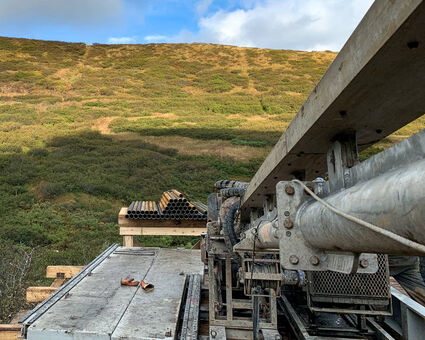Drilling expands SH-1 gold zone at Unga
Heliostar hits 5.5 meters of 8.32 g/t gold near the surface North of 60 Mining News – February 19, 2021
Last updated 2/18/2021 at 5:50pm

Heliostar Metals Ltd.
Heliostar Metals' 2020 program included nine holes testing the expansion of SH-1, an Unga deposit that hosts 384,318 oz of gold and 986,321 oz of silver in the inferred resource category.
Heliostar Metals Ltd. Feb. 18 reported additional strong gold mineralization from a late-2020 drill program testing resource expansion targets at the SH-1 zone on its Unga project in Southwest Alaska.
The Unga project covers roughly 93 square miles (240 square kilometers) of the Unga and Popof islands of the southern coast of the Alaska Peninsula. The Apollo and adjacent Sitka mines, established on Unga Island in 1886, produced roughly 150,000 ounces of gold from high-grade epithermal veins before they were shuttered in 1922.
Much of Heliostar's exploration in recent years has focused on two high-grade gold trends – Apollo-Sitka and Shumagin – that each cut roughly six miles across Unga Island. Apollo-Sitka hosts the historic Apollo Mine and Shumagin is a parallel high-grade gold trend about 2,000 meters to the northwest.
SH-1, which is found along the Shumagin trend, hosts 866,015 metric tons of inferred resource averaging 13.8 grams per metric ton (384,318 ounces) gold and 35.4 g/t (986,321 oz) silver.
Late last year, Heliostar drilled nine holes to test expansion target areas at SH-1, including seven that targeted underexplored area in the upper 100 meters of the main SH-1 shoot.
The first two holes from this program, announced by the company in January, encountered high-grade gold.
• SH20-01A, cut 11.65 meters averaging 7.74 g/t gold and 27 g/t silver from a depth of 12.95 meters, including four meters of 16.06 g/t gold and 37.7 g/t silver.
• 2H20-02, cut 1.98 meters averaging 18.66 g/t gold and 11.5 g/t silver from a depth of 50.75 meters.
The latest batch of assays included four holes drilled in the upper area of SH-1. Highlights from this drilling include:
• SH20-03, cut 6.97 meters averaging 6.66 g/t gold and 11.7 g/t silver from a depth of 20 meters, including 5.52 meters of 8.32 g/t gold and 12 g/t silver.
• 2H20-04, cut 4.42 meters averaging 5.13 g/t gold and 14.6 g/t silver from a depth of 13.26 meters.
Heliostar also completed two deeper holes in 2020 to test depth extensions in areas of widely spaced drilling at SH-1. The company says these holes each intersected a wide vein of low-grade gold mineralization. Epithermal veins, however, have natural variability in the distribution of mineralization.
The deepest hole drilled so far at SH-1, BM-01, cut 5.48 meters averaging 23.99 g/t gold and the company plans to drill another eight to 10 holes and will continue to expand to depth where the system remains open.
Drilling along strike from the Main Shoot indicates parallel zones of mineralization that remain open and will also be tested when drilling recommences next month.
"The company is preparing to recommence drilling at Unga in late March to continue infilling and stepping beneath open intersections at the SH-1 zone," said Heliostar Metals CEO Charles Funk.
Pending assays from 2020 drilling in the Apollo-Sitka Mine area and the Aquila zone are expected in the coming weeks.














Reader Comments(0)